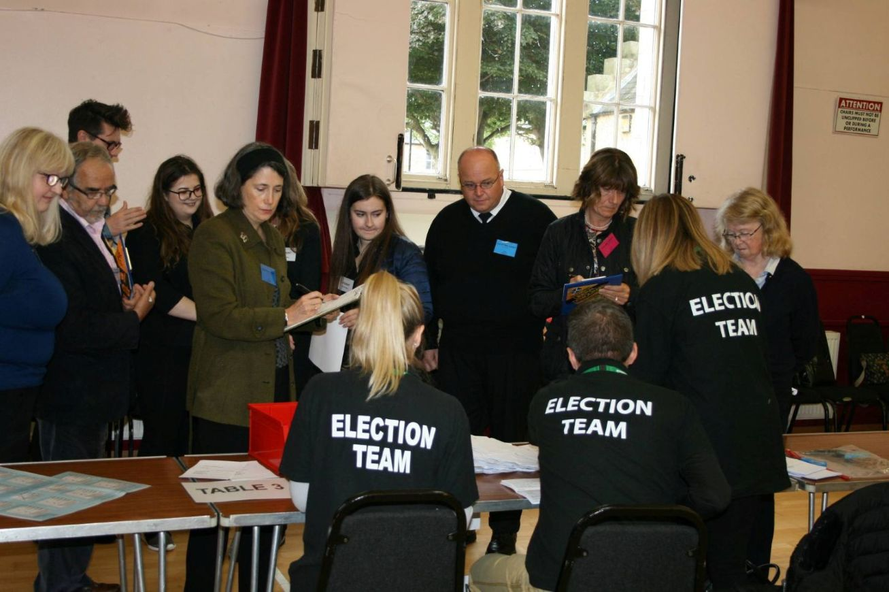When and why do by-elections happen?

The count at the 2017 Tain & Easter Ross by-election, one of the first we covered.
Democracy Club has been covering by-elections to all levels of UK government (except parish and community councils) since 2017. We’ve recently improved this service, and are now collecting the reason for each vacancy, to give voters more information about why they are going to the polls. You can see these reasons displayed on the ballots accessible from the front page of Who Can I Vote For?
Frequency of by-elections
Democracy Club has been covering by-elections since mid-2017. Since then we’ve seen an average of 230 a year, or slightly under 200 if we exclude those not combined with national elections (these figures do not include town and parish councils). At least one by-election occurs every week, with some rare exceptions.
By-elections do not have to be held on Thursdays. Unlike scheduled elections, returning officers are responsible for choosing the date of by-elections, and can pick any weekday. Since May 2017 we’ve covered 48 non-Thursday polls: two Mondays, 22 Tuesdays, and 24 Wednesdays.
When a vacancy means a by-election
A by-election is an election held to fill a vacancy created by the removal of an elected member. The requirement for a by-election is different depending on the organisation, or how the member was elected.
By-elections are usually held to fill vacancies in the UK Parliament, though they are sometimes left if a general election is due to happen soon. They are also held for vacancies on British councils, unless the member being replaced would have been up for re-election within the next six months (the ‘six-month rule’). In this case the vacancy remains until the next scheduled elections.
The Scottish and Welsh parliaments are both elected using the Additional Member System, which involves some members elected for constituencies using First Past the Post, and others representing regional seats. Vacancies in constituencies are filled in by-elections in the usual way. Regional vacancies, on the other hand, are filled by the next person on that party’s list. If the member had been elected as an independent, the vacancy is not filled at all. From May 2026 the Senedd is moving to a system of large regional constituencies. This will treat vacancies in the same way as the current regional seats, meaning that there will be no Senedd by-elections in the future.
In Northern Ireland, by-elections to the Assembly and councils are almost unheard of. Since 2010, vacancies to these organisations have been filled by co-option. Between then and now there has only been a single by-election (in 2018), caused by a councillor dying with no eligible successors. Co-option is used to ensure that the Assembly and councils retain the same (political) composition between scheduled elections, but it is not uncontroversial. The Electoral Commission, among other organisations, has recently called for reform to allow by-elections to occur.
How do vacancies occur?
Vacancies can occur for a variety of reasons - the Electoral Commission has helpfully compiled a list of them for council elections. In summary, these are:
- Death.
- Resignation.
- The member is disqualified from sitting, for reasons such as taking paid employment in the organisation they have been elected to, becoming bankrupt, or sentenced for a period of three or more months in prison.
- Failure to attend meetings of the council for a period of six months (some exemptions apply).
- An election court declares the election void, for example due to irregularities or corruption.
- The member was qualified to sit as a councillor only because they were registered to vote, but subsequently lost this qualification.
- Failure to sign the declaration of acceptance of office.
Additionally, in the UK parliament a constituency can petition to recall their member if convicted of a crime or suspended from the House of Commons. If successful, this process leads to a vacancy and therefore a by-election.
Our by-election coverage
As mentioned, we’ve supported by-elections on our services since mid-2017. Over the years we’ve seen interest in by-elections increase significantly. Individual council by-elections on Who Can I Vote For? regularly receive over 1,000 views a week. A large number of site visitors also arrive immediately after a result has been announced, as people look up the winning candidate.
A common question we get from voters is ‘why is there a by-election in my area?’. To provide the beginnings of an answer, we’ve started storing the reason for each by-election in our system. This is displayed as a single sentence on Who Can I Vote For? ballot pages, and is available in our API and CSV downloads.
We’ve now collected the reasons for all elections in September, October, and November, which gives us sixty-nine vacancies: two disqualifications, 14 deaths, and 51 resignations. You can get the data from our candidates site.
You can help!
Are you a by-election candidate or party supporter, or simply interested in collecting information on candidates to help your fellow citizens vote? Who Can I Vote For offers a free profile to every candidate, to help them put their case to the electorate. Find out more.